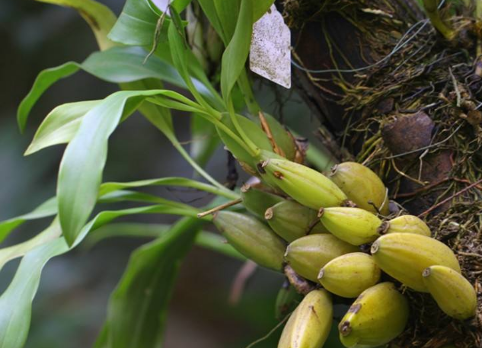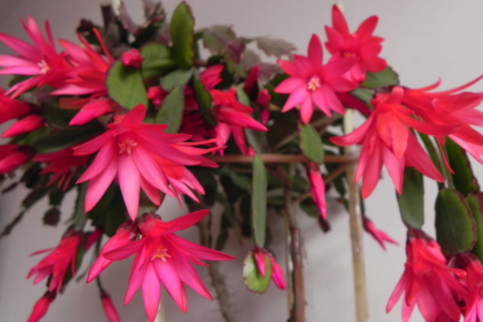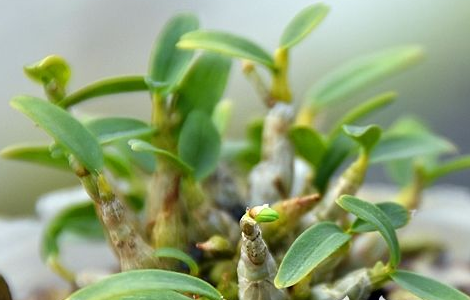Ramet propagation of Cartland
Cartland is usually selected and propagated, usually in the spring and autumn rainy season. The rhizome at the base of it can be carefully cut with a knife, and each clump should have 2 pseudobulbs with new buds.

How does Cartland reproduce, divide and cultivate aseptically?
Cartland commonly uses ramet propagation methods for reproduction, and some flower friends use aseptic breeding methods. Here are Cartland's ramet and aseptic breeding methods and steps.
How to reproduce Cartland 1. Ramet propagation method
Cartland ramet time. You can choose to split plants during the spring and autumn rainy season. Flower friends can first use sharp cutting tools to cut the roots at the base of Cartland and cut them off for disinfection. Each clump needs at least two pseudobulbs with new buds, and then plant the new buds in pots.
2. Aseptic breeding
First of all, the ripe fruit should be selected and soaked in 75% alcohol for half a minute, then sterilized, put the fruit in 0.1% mercury solution, soaked for 20 minutes, then washed with sterile water for 4 or 5 times, and then cut open, the white powdery seeds were inoculated into the seed germination liquid culture medium, and the 150rpm shaker vibrated.
Generally, the embryo germinates after a week, and the green protocorm with a diameter of 1-2mm is formed in 20 days.
The protocorm was inoculated on the seedling culture base with a straw, and a complete plantlet could be formed in one month, and it could grow into a strong and healthy seedling for 45 days.
When the test-tube plantlets could grow to 3 cm high and 4 cm high, they were transferred to natural light for 1-2 weeks, and the investigated plants formed a better stratum corneum. After taking it out of the glass bottle, wash the root culture base, move it into the mixed pond pillar and carbonized bark matrix, adhere to the appropriate humidity, and do a good job of ventilation.
How does Cartland reproduce?
Ramet propagation of Cartland
The ramet method is relatively simple to operate and can be used by ordinary families. It is suitable to choose the rainy season in spring and autumn to carry out ramet work. Use a sharp cutting tool to cut the root between the two "orchid heads", carefully cut the rhizome at the base, and disinfect the incision. Each clump requires at least 2 pseudobulbs with new buds.
Aseptic seeding and tissue Culture of Cartland
In the early stage, liquid culture is mainly used to promote the rapid germination of seeds, and then the protocorm can be directly inoculated on the culture medium to achieve one-step seedling formation, the specific steps are as follows:
Materials
The healthy Cartland mother plant was selected for self-pollination and hybridization during flowering, and the fruit could be basically matured about 120-150 days after pollination.
Aseptic sowing
Select the ripe fruit, soak the fruit with 75% alcohol for half a minute, then disinfect the fruit, put the fruit in 0.1% mercury solution, soak for 20 minutes, rinse the fruit with sterile water for 4 or 5 times, then cut the fruit, inoculate the white powdery seeds in the seed germination liquid medium, and shake the culture in 150rpm shaker. A week later, the embryo germinated and a green protocorm with a diameter of 1-2mm was formed in 20 days.
Seedling culture
When the protocorms were inoculated on the seedling culture medium with a straw, the complete plantlets could be formed in one month, and the seedlings could grow into strong seedlings after further culture for 45 days.
Transplanting of test tube plantlets
When the test-tube plantlets can grow to 3pm and 4cm high, they were transferred to natural light for 1-2 weeks to observe the formation of better cuticular layer. After taking it out of the glass bottle, wash the root culture medium and move it into the cornerstone of the mixing pond and carbonized bark matrix to maintain proper humidity and ventilation.
- Prev

What if the dance of falling flowers does not blossom
The flowering of the mother plant of falling flowers is different from that of cutting or grafting. Generally speaking, the growth state of the mother plant will be better after it is propagated by cutting or grafting, but the mother plant will wither. However, one of the advantages of the mother plant is that it can easily grow buds.
- Next

Aseptic seeding and tissue Culture of Cartland
When the fruit was cultivated and flowered, the mother plants with better growth were selected for self-pollination and hybridization, and the mature fruit could grow 4-5 months after pollination. Sow the ripe fruit in aseptic sowing, soak it in 75% alcohol for half a minute and soak it in 0.1% mercury solution for 20 minutes.
Related
- Fuxing push coffee new agricultural production and marketing class: lack of small-scale processing plants
- Jujube rice field leisure farm deep ploughing Yilan for five years to create a space for organic food and play
- Nongyu Farm-A trial of organic papaya for brave women with advanced technology
- Four points for attention in the prevention and control of diseases and insect pests of edible fungi
- How to add nutrient solution to Edible Fungi
- Is there any good way to control edible fungus mites?
- Open Inoculation Technology of Edible Fungi
- Is there any clever way to use fertilizer for edible fungus in winter?
- What agents are used to kill the pathogens of edible fungi in the mushroom shed?
- Rapid drying of Edible Fungi

